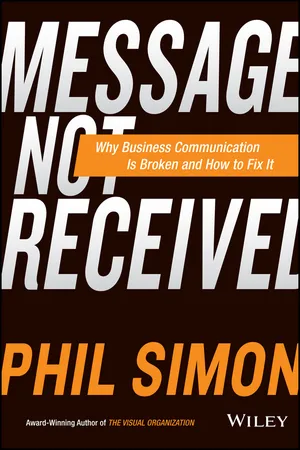
- English
- ePUB (mobile friendly)
- Available on iOS & Android
About This Book
Get your message across the right way with clear communication
Message Not Received provides the tools and techniques that make an effective writer and public speaker. Particularly on topics related to data and technology, effective communication can present a challenge in business settings. This book shows readers how those challenges can be overcome, and how to keep the message from getting lost in the face of mismatched levels of knowledge, various delivery media, and the library of jargon that too often serves as a substitute for real, meaningful language. Coverage includes idea crystallization, the rapidly changing business environment, Kurzweil's law of accelerating change, and our increasing inability to understand what we are saying to each other. Rich with visuals including diagrams, slides, graphs, charts, and infographics, this guide provides accessible information and actionable guidance toward more effectively conveying the message.
Today, few professionals can ignore the tsunami of technology that permeates their lives, advancing far more rapidly that most of us can handle. As a result, too many people think that successful speaking means using buzzwords, jargon, and invented words that sound professional, but don't actually communicate meaning. This book provides a path through the noise, helping readers get their message across succinctly, efficiently, and effectively.
- Adapt your approach for more effective communication
- Learn the critical skill of crystallizing ideas
- Tailor your style to the method of delivery
- Ensure that your message is heard, understood, and internalized
It doesn't matter whether you're pitching to a venture capitalist, explaining daily challenges to a non-tech manager, or speaking to hundreds of people – jargon-filled word salad uses a lot of words to say very little. Better communication requires a different approach, and Message Not Received gives you a roadmap to more effective speaking and writing for any audience or medium.
Frequently asked questions
PART I
WORLDS ARE COLLIDING
- Introduction: The Intersection of Business, Language, Communication, and Technology
- Chapter 1: Technology Is Eating the World: The Dizzying Nature of Today’s Existence
- Chapter 2: The Increasingly Overwhelmed Employee: Is This Becoming the New Normal?
Introduction
The Intersection of Business, Language, Communication, and Technology
The single biggest problem in communication is the illusion that it has taken place.—George Bernard Shaw
Subject: The Other Scourge of Business Communication
Technology and the Cardinal Importance of Business Communication
What’s the Big Whoop?
- An endless chain of baffling, jargon-laden e-mails
- Simple, clear, and honest conversations either in person or via a truly collaborative tool
Table of contents
- Cover
- Praise
- Title Page
- Copyright
- Other Books
- Dedication
- Epigraph
- Preface
- Part I Worlds are Colliding
- Part II Didn’t You Get That Memo?
- Part III Message Received
- Part IV What Now?
- Acknowledgments
- Thank You
- Selected Bibliography
- About the Author
- Index
- End User License Agreement